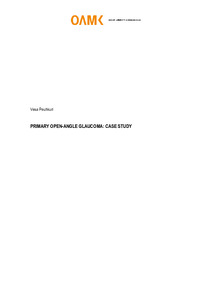Primary Open-Angle Glaucoma: Case Study
Peuhkuri, Vesa (2022)
Julkaisun pysyvä osoite on
https://urn.fi/URN:NBN:fi:amk-2022100220732
https://urn.fi/URN:NBN:fi:amk-2022100220732
Tiivistelmä
Purpose: This study aims to evaluate the potential of teleophthalmology in glaucoma screening at optometrists’ appointments.
Methods: This clinical case example study describes how teleophthalmology was used in a primary open-angle glaucoma patient’s follow-up assessment and management at an optical chain-owned practice in 2022. A literature search was conducted using PubMed, Cochrane, and Springer in January 2022. One hundred thirty-one (n = 131) texts were retrieved, and twenty-seven (n = 27) articles were deemed eligible for full-text review. Twelve (n = 12) studies were included in the literature review.
Results: Teleophthalmology can provide high-quality screening and effectively target primarily at-risk groups. The case study patient was previously diagnosed with glaucoma and has risk factors. In the case study patient´s visual acuity was 20/25-2 in both eyes, and topography revealed moderate astigmatism in both eyes. The patient’s intraocular pressures were between average values, and the papilla OCT revealed no significant glaucomatous defects. Visual fields on the right had no defects, but the left field had unreliable measurements. Teleophthalmology equipment and conventional slit-lamp examination provide high sensitivity and specificity for optometrists’ to detect glaucomatous defects, according to the literature. This single case study could not verify the time and cost savings suggested in the literature. Teleophthalmology provided an effective tool for patient education and annual follow-ups, as the literature suggested. Based on the literature, if optometrists have higher education or have got special training, their ability to detect glaucomatous defects is better than without education or special training.
Conclusion: Primary open-angle glaucoma is a relatively slow progressive and multifactorial disease. Optometrists have an excellent understanding of vision-related problems, and together with teleophthalmology, they may be able to provide primary open-angle glaucoma follow-ups. The role of education for optometrists is the key to high-quality primary open-angle glaucoma follow-ups.
Keywords: glaucoma, primary open-angle glaucoma, teleophthalmology, teleglaucoma, optometrist, optometry
Methods: This clinical case example study describes how teleophthalmology was used in a primary open-angle glaucoma patient’s follow-up assessment and management at an optical chain-owned practice in 2022. A literature search was conducted using PubMed, Cochrane, and Springer in January 2022. One hundred thirty-one (n = 131) texts were retrieved, and twenty-seven (n = 27) articles were deemed eligible for full-text review. Twelve (n = 12) studies were included in the literature review.
Results: Teleophthalmology can provide high-quality screening and effectively target primarily at-risk groups. The case study patient was previously diagnosed with glaucoma and has risk factors. In the case study patient´s visual acuity was 20/25-2 in both eyes, and topography revealed moderate astigmatism in both eyes. The patient’s intraocular pressures were between average values, and the papilla OCT revealed no significant glaucomatous defects. Visual fields on the right had no defects, but the left field had unreliable measurements. Teleophthalmology equipment and conventional slit-lamp examination provide high sensitivity and specificity for optometrists’ to detect glaucomatous defects, according to the literature. This single case study could not verify the time and cost savings suggested in the literature. Teleophthalmology provided an effective tool for patient education and annual follow-ups, as the literature suggested. Based on the literature, if optometrists have higher education or have got special training, their ability to detect glaucomatous defects is better than without education or special training.
Conclusion: Primary open-angle glaucoma is a relatively slow progressive and multifactorial disease. Optometrists have an excellent understanding of vision-related problems, and together with teleophthalmology, they may be able to provide primary open-angle glaucoma follow-ups. The role of education for optometrists is the key to high-quality primary open-angle glaucoma follow-ups.
Keywords: glaucoma, primary open-angle glaucoma, teleophthalmology, teleglaucoma, optometrist, optometry
